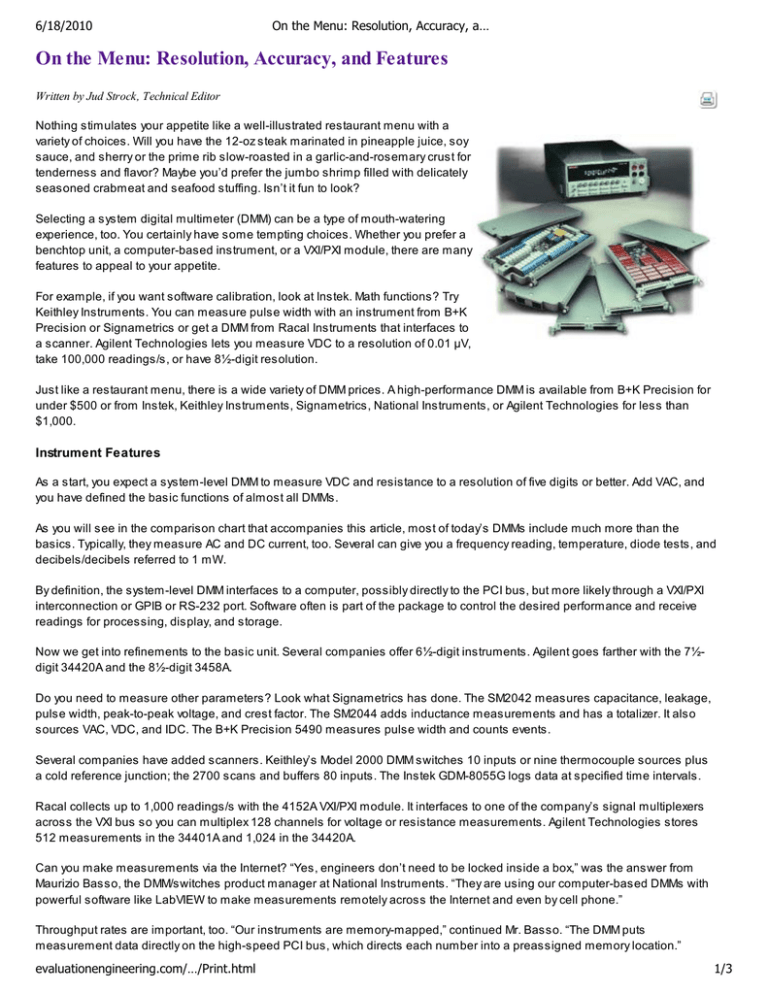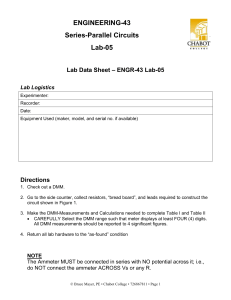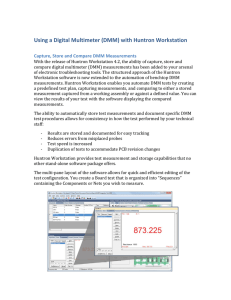On the Menu: Resolution, Accuracy, and Features
advertisement

6/18/2010 On the Menu: Resolution, Accuracy, a… On the Menu: Resolution, Accuracy, and Features Written by Jud Strock, Technical Editor Nothing stimulates your appetite like a well-illustrated restaurant menu with a variety of choices. Will you have the 12-oz steak marinated in pineapple juice, soy sauce, and sherry or the prime rib slow-roasted in a garlic-and-rosemary crust for tenderness and flavor? Maybe you’d prefer the jumbo shrimp filled with delicately seasoned crabmeat and seafood stuffing. Isn’t it fun to look? Selecting a system digital multimeter (DMM) can be a type of mouth-watering experience, too. You certainly have some tempting choices. Whether you prefer a benchtop unit, a computer-based instrument, or a VXI/PXI module, there are many features to appeal to your appetite. For example, if you want software calibration, look at Instek. Math functions? Try Keithley Instruments. You can measure pulse width with an instrument from B+K Precision or Signametrics or get a DMM from Racal Instruments that interfaces to a scanner. Agilent Technologies lets you measure VDC to a resolution of 0.01 µV, take 100,000 readings/s, or have 8½-digit resolution. Just like a restaurant menu, there is a wide variety of DMM prices. A high-performance DMM is available from B+K Precision for under $500 or from Instek, Keithley Instruments, Signametrics, National Instruments, or Agilent Technologies for less than $1,000. Instrument Features As a start, you expect a system-level DMM to measure VDC and resistance to a resolution of five digits or better. Add VAC, and you have defined the basic functions of almost all DMMs. As you will see in the comparison chart that accompanies this article, most of today’s DMMs include much more than the basics. Typically, they measure AC and DC current, too. Several can give you a frequency reading, temperature, diode tests, and decibels/decibels referred to 1 mW. By definition, the system-level DMM interfaces to a computer, possibly directly to the PCI bus, but more likely through a VXI/PXI interconnection or GPIB or RS-232 port. Software often is part of the package to control the desired performance and receive readings for processing, display, and storage. Now we get into refinements to the basic unit. Several companies offer 6½-digit instruments. Agilent goes farther with the 7½digit 34420A and the 8½-digit 3458A. Do you need to measure other parameters? Look what Signametrics has done. The SM2042 measures capacitance, leakage, pulse width, peak-to-peak voltage, and crest factor. The SM2044 adds inductance measurements and has a totalizer. It also sources VAC, VDC, and IDC. The B+K Precision 5490 measures pulse width and counts events. Several companies have added scanners. Keithley’s Model 2000 DMM switches 10 inputs or nine thermocouple sources plus a cold reference junction; the 2700 scans and buffers 80 inputs. The Instek GDM-8055G logs data at specified time intervals. Racal collects up to 1,000 readings/s with the 4152A VXI/PXI module. It interfaces to one of the company’s signal multiplexers across the VXI bus so you can multiplex 128 channels for voltage or resistance measurements. Agilent Technologies stores 512 measurements in the 34401A and 1,024 in the 34420A. Can you make measurements via the Internet? “Yes, engineers don’t need to be locked inside a box,” was the answer from Maurizio Basso, the DMM/switches product manager at National Instruments. “They are using our computer-based DMMs with powerful software like LabVIEW to make measurements remotely across the Internet and even by cell phone.” Throughput rates are important, too. “Our instruments are memory-mapped,” continued Mr. Basso. “The DMM puts measurement data directly on the high-speed PCI bus, which directs each number into a preassigned memory location.” evaluationengineering.com/…/Print.html 1/3 6/18/2010 On the Menu: Resolution, Accuracy, a… Accuracy Specification The method used to specify accuracy on a DMM varies from supplier to supplier so it requires some deciphering when comparing the advertised specifications. Some companies, including Signametrics, relate accuracy to the reading plus a specific number of counts, for example, ±(0.005% of the reading + 2 counts). Others, like Agilent Technologies, specify a percent of the reading plus a percent of full scale: ±(0.005% of the reading + 0.005% full scale). A third way, used on some Keithley Instruments’ equipment for example, defines accuracy as a percent of the reading plus a fixed number of units of the measurement: ±(0.005% of the reading + 300 µV). Still a fourth method is used by Racal Instruments and National Instruments, where the company wraps the whole accuracy specification into ±(0.010% of the reading). One way to get a meaningful evaluation of instruments is to choose a specific measurement and look at the specifications on the comparison chart for that parameter. For example, comparing 6½-digit instruments in their measurement of 100 VDC, we get an accuracy range of 0.003% to 0.014%. Studying the Agilent Technologies 6½-digit, 7½-digit, and 8½-digit meters, we see that the accuracies are 0.014%, 0.011%, and 0.009%, respectively. This underscores the fact that resolution is not to be confused with accuracy. In many cases, accuracy, sensitivity, and noise rejection on low-level measurements can be improved with existing instruments by optimizing the measurement techniques. Factors to consider are thermal EMF interference, magnetic fields, and ground loops.1 Operating Software “From the user’s point of view, a DMM is a tool much like a screwdriver,” according to Mark Bailey, product manager at Agilent Technologies. “Anything we can do to minimize the hassle of operating it will make the user happy. To that end, it is important to have drivers that work comfortably with popular software packages.” Continuing that theme, Mark Cejer, the telecom test business manager at Keithley Instruments, said, “Our Xlinx software package lets the first-time user begin logging data into Microsoft Excel in minutes. From that point, data can be manipulated, graphed, exported, and shared. More advanced users may go to LabVIEW, Agilent VEE, or TestPoint to create more sophisticated test and measurement programs. There is a broad level of cooperation between software and hardware suppliers to support these advanced users. “Software such as ActiveX Controls provides the maximum degree of flexibility for seasoned users who choose to create their own test programs with Visual BASIC, C, and C++,” he continued. “Interestingly, the difference between the most basic and the most advanced implementations is not as great as it once was. Some users move through the levels as their applications and skills evolve.” Interchangeability is becoming an important issue for many high-volume manufacturers, according to Mr. Basso of National Instruments. “A real unknown for the test-system user is how much time must be spent revising software when a DMM is taken out of service for repair or calibration and replaced with an instrument of a different type,” he said. “The Interchangeable Virtual Instruments (IVI) Consortium is working to define software standards for instrument interchangeability and has defined the DMM driver standards already. This will make IVI-driven instruments interchangeable without software revisions and help users preserve their investment in setup programs,” Mr. Basso concluded. The Future of DMMs With all the capability that is on the market now, what advances could possibly be in the future plans of DMM suppliers? Why should anyone need more than 8½ digits of resolution or more than 100,000 readings/s? It isn’t likely. DC voltage accuracies of 0.00005% are possible and that satisfies virtually any need. So what can the DMM designers do for you now? Advances in DMM design will continue because components such as analog-to-digital converters, surface-mount technology, and display devices are in a continual mode of improvement. The heart of any DMM is its internal voltage reference, and better stability in these circuits has already helped improve the instrument. Also new DSPs will play an important role as they let designers move beyond the traditional functions of voltage, current, and resistance measurements. evaluationengineering.com/…/Print.html 2/3 6/18/2010 On the Menu: Resolution, Accuracy, a… “The availability of better low-noise amplifiers, high-stability resistive dividers, and low-thermal EMF relays for internal range switching and external multiplexing will continue to advance DMM technology,” is the opinion of Charles Greenberg, the product marketing engineer at Racal Instruments. “Being able to look at as many as 128 inputs on a single DMM without moving a test lead is very important in the fast-paced automated test environment.” Reference 1. O’Shea, P. “Increase the Accuracy of Low-Level Measurements,” EE-Evaluation Engineering, August 1998, pp. 18-25. Return to EE Home Page Published by EE-Evaluation Engineering All contents © 2000 Nelson Publishing Inc. No reprint, distribution, or reuse in any medium is permitted without the express written consent of the publisher. August 2000 Tags: accuracy and features august 2000 evaluationengineering.com/…/Print.html instrumentation on the menu: resolution 3/3






